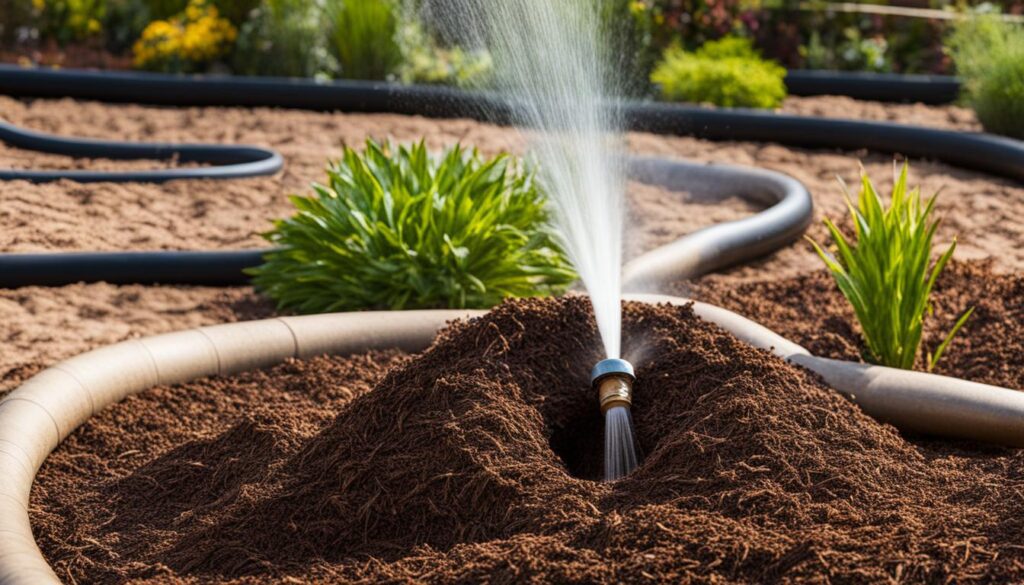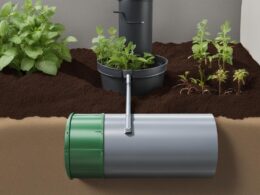Are you looking for a cost-effective and sustainable way to create a beautiful, lush yard? Look no further than xeriscaping! This landscaping technique focuses on creating stunning outdoor spaces in dry climates, all while conserving water and saving money. By incorporating mulch into your xeriscaping efforts, you can achieve budget-friendly landscaping that is both visually appealing and environmentally friendly.
Key Takeaways:
- Xeriscaping is a landscaping technique that creates beautiful yards in dry climates.
- By using mulch in your xeriscaping efforts, you can save money on water bills and reduce water usage.
- Xeriscaping requires strategic planning, suitable plant selection, efficient irrigation, and the use of eco-friendly landscaping elements.
- Native plants, proper plant placement, and irrigation efficiency are key factors in successful xeriscaping.
- Xeriscaping not only benefits your wallet but also helps conserve water resources and promote a sustainable environment.
The Principles of Xeriscaping
Xeriscaping is based on several key principles that focus on water conservation, efficient irrigation, and sustainable landscaping practices. By following these principles, you can create a beautiful and environmentally friendly landscape that requires minimal water and maintenance.
1. Planning and Design
Start by understanding your climate and soil conditions to determine the best landscaping practices for your area. Consider factors such as sunlight exposure, rainfall patterns, and soil type. Plan your landscape design accordingly, incorporating features like water-efficient pathways, rock gardens, and efficient irrigation systems.
2. Suitable Plant Selection
Selecting the right plants is crucial for a successful xeriscaping project. Choose native plants that are well-adapted to your climate, as they are more likely to thrive with less water. Native plants have evolved to withstand local conditions and require minimal maintenance. Additionally, grouping plants with similar water needs together can help optimize water usage and reduce wastage.
3. Soil Tests and Improvements
Conduct soil tests to understand the nutrient levels and pH balance of your soil. Based on the test results, make necessary amendments to improve soil quality and water retention. Adding organic matter such as compost or mulch can enhance the soil’s ability to retain moisture and promote healthy root growth.
4. Efficient Irrigation
Implementing efficient irrigation techniques is essential for conserving water in xeriscaping. Consider using drip irrigation systems that deliver water directly to the root zone of plants, minimizing evaporation and runoff. Install rain sensors and timers to optimize watering schedules based on weather conditions. Regularly check for leaks or malfunctions in the irrigation system to prevent water wastage.
| Principles of Xeriscaping | Summary |
|---|---|
| Planning and Design | Understand your climate and design a landscape that maximizes water efficiency. |
| Suitable Plant Selection | Choose native plants adapted to your climate for minimal water requirements. |
| Soil Tests and Improvements | Conduct soil tests and amend the soil to improve water retention. |
| Efficient Irrigation | Implement drip irrigation and use timers to optimize water usage. |
5. The Use of Mulch
Mulching plays a vital role in xeriscaping as it helps conserve moisture, suppresses weeds, and regulates soil temperature. Apply a layer of organic mulch such as wood chips or bark around plants to retain moisture and reduce evaporation. Mulch also helps prevent soil erosion and adds aesthetic appeal to your landscape.
6. Applicable Maintenance
Maintaining your xeriscaped garden involves periodic pruning, weeding, and monitoring for pests or diseases. Remove any dead plants or debris to maintain the overall health and aesthetics of your landscape. Regularly assess your irrigation system for any necessary adjustments or repairs to ensure efficient water usage.
Xeriscaping is an eco-friendly and cost-effective approach to landscaping that prioritizes water conservation. By following these xeriscaping principles, you can create a visually stunning and sustainable landscape while minimizing water usage and maintenance.
The Benefits of Xeriscaping
Xeriscaping offers numerous benefits for homeowners and the environment alike. By incorporating this sustainable landscaping technique, you can enjoy water conservation, cost savings, and low maintenance in your yard.
Water Conservation
One of the primary advantages of xeriscaping is its ability to conserve water. Traditional landscaping often requires large amounts of irrigation, leading to water waste. Xeriscaping, on the other hand, focuses on using native plants that are adapted to the local climate and require less water. By selecting drought-tolerant plants and implementing efficient irrigation systems, you can significantly reduce your water usage. This is especially beneficial in areas with limited access to water, where xeriscaping can make a significant difference in preserving this precious resource.
Cost Savings
Another appealing aspect of xeriscaping is the potential for cost savings. By minimizing your water usage, you can save money on your water bills over time. Additionally, xeriscaping requires less maintenance compared to traditional landscaping, which often involves regular mowing, fertilizing, and watering. With xeriscaping, you can spend less time and money on maintenance tasks, allowing you to enjoy your yard without continuous work and expenses.
Low Maintenance
Xeriscaping is known for its low maintenance requirements. By incorporating native plants that are well-suited to the local climate, you can create a landscape that thrives with minimal care. Native plants are adapted to the conditions of the region and generally require less water, fertilizer, and pesticide use. This not only saves you time and effort but also promotes a healthier and more sustainable environment. With xeriscaping, you can enjoy a beautiful yard that requires minimal maintenance, allowing you to focus on other activities and interests.
In summary, xeriscaping offers a range of benefits, including water conservation, cost savings, and low maintenance. By implementing this sustainable landscaping technique, you can create a beautiful and eco-friendly yard while reducing your environmental impact. Whether you reside in a dry climate or simply want to make a positive difference, xeriscaping is a practical and rewarding choice.
How to Xeriscape Your Garden
Xeriscaping your garden is a simple and rewarding process that promotes water conservation and creates a sustainable landscape. By following a few key steps, you can transform your outdoor space into a vibrant and eco-friendly oasis.
Native Plant Selection
One of the foundational elements of xeriscaping is choosing native plants that are well-suited to your climate and require less water. Native plants have adapted to the local conditions and are naturally more resilient, making them ideal for water-efficient landscaping. Consider researching and selecting native species that thrive in your specific region. These plants will not only require less water but also provide habitat and food sources for local wildlife, contributing to the overall biodiversity of your garden.
Eco-Friendly Landscaping Elements
Incorporating eco-friendly elements into your xeriscaped garden can further enhance its sustainability. One key element to consider is the use of mulch. Mulching helps retain soil moisture, suppress weed growth, and insulate plant roots from extreme temperatures. Choose organic mulch, such as wood chips or shredded bark, as it breaks down over time, enriching the soil with nutrients. Composting is another eco-friendly practice that can improve soil quality and reduce the need for chemical fertilizers. By recycling kitchen scraps and yard waste, you can create nutrient-rich compost to nourish your plants.
Water Conservation Techniques
Water conservation is at the core of xeriscaping, and there are several techniques you can implement to minimize water usage. Proper plant placement is essential for efficient water distribution. Group plants with similar water needs together, ensuring that they receive the appropriate amount of moisture. Additionally, implementing rainwater harvesting techniques can help capture and store rainwater for later use. This can be as simple as installing rain barrels or utilizing a more advanced rainwater collection system. By maximizing the use of natural rainfall, you can significantly reduce your reliance on municipal water sources.
| Benefits of Xeriscaping | Native Plant Selection | Eco-Friendly Landscaping Elements | Water Conservation Techniques |
|---|---|---|---|
| – Water conservation | – Choose native species | – Use organic mulch | – Proper plant placement |
| – Cost savings | – Promote biodiversity | – Composting | – Rainwater harvesting |
| – Low maintenance | – Provide habitat for wildlife |
By implementing these strategies, you can successfully xeriscape your garden, creating a beautiful and sustainable landscape that conserves water and supports local ecosystems. Xeriscaping not only benefits the environment but also provides a low-maintenance and aesthetically pleasing outdoor space for you to enjoy.
Expert Tips for Successful Xeriscaping
When it comes to successful xeriscaping, there are a few expert tips that can help you maximize your efforts and create a thriving, eco-friendly landscape. One key aspect to focus on is irrigation efficiency. By optimizing your watering system and utilizing smart controllers for automatic adjustments, you can ensure that water is used effectively and efficiently. Getting an irrigation audit can also provide valuable insights into areas where you can improve irrigation practices.
In addition to irrigation efficiency, utilizing local resources is another important tip for successful xeriscaping. Local native plant nurseries and botanic gardens can provide guidance and offer workshops on xeriscaping specific to your region. They can help you select the right native plants that are adapted to the local climate and require less water. By utilizing local resources, you can tap into expertise and knowledge that is tailored to your specific location.
“Utilize local native plant nurseries and botanic gardens for guidance and workshops on xeriscaping.”
Creating a habitat for wildlife is another aspect to consider when practicing xeriscaping. By incorporating native plants into your landscape, you can attract native insects and other wildlife, promoting biodiversity and creating a sustainable ecosystem. Native plants provide a food source and habitat for local pollinators and other beneficial insects, which play a crucial role in maintaining a healthy garden ecosystem.
Expert Tip: Be mindful of water needs
When selecting and grouping plants in your xeriscape garden, it’s important to be mindful of their water needs. Grouping plants with similar water requirements together can help minimize water waste and ensure that each plant receives the appropriate amount of water. This practice not only promotes efficient water usage but also helps plants thrive and reduces the risk of overwatering or underwatering.
By following these expert tips for successful xeriscaping, you can create a sustainable and visually stunning landscape that conserves water, utilizes local resources, and provides a habitat for wildlife. Implementing irrigation efficiency techniques, tapping into local expertise, and being mindful of water needs are key steps towards achieving a successful xeriscape garden.
How Can I Incorporate Budget-Friendly Mulching into my Xeriscaping?
Incorporating budget-friendly mulching into your xeriscaping can be achieved by using the best mulch for xeriscapes, such as wood chips, straw, or compost. These options not only help conserve water and control weeds but also add aesthetic value to your landscaping while being cost-effective.
Conclusion
Xeriscaping offers a wide range of benefits, making it an excellent choice for sustainable landscaping. By implementing this budget-friendly technique, you can achieve water conservation, create a visually stunning yard, and enjoy a low-maintenance landscape.
One of the key advantages of xeriscaping is water conservation. With strategic planning and efficient irrigation systems, you can significantly reduce your water usage. This not only helps protect a precious natural resource but also contributes to a sustainable environment.
Furthermore, xeriscaping promotes sustainable landscaping by incorporating native plants and eco-friendly elements. By selecting native plants that are well-suited to your climate, you can create a thriving garden that requires less water and maintenance. Additionally, utilizing eco-friendly elements like mulch and compost improves soil quality and water retention, further enhancing the resilience of your landscape.
In conclusion, xeriscaping is an ideal solution for those seeking an environmentally friendly and cost-effective landscaping approach. By embracing this technique, you can enjoy the benefits of water conservation, achieve a beautiful and sustainable landscape, and contribute to a greener future.











